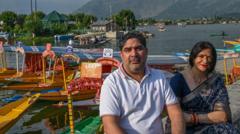How is Kashmir Rebuilding After April's Tragic Killings?

# The Resurgence of Tourism in Kashmir: A Valley's Journey from Fear to Hope
The picturesque valley of Kashmir, cradled in the embrace of the Himalayan mountains, has long been a coveted destination for travelers seeking breathtaking landscapes, rich culture, and a unique blend of history. However, the region has also faced its fair share of turmoil, affecting its tourism sector. Recently, a deadly attack near Pahalgam sent shockwaves through the tourism industry, causing a dramatic downturn. Yet, just two months later, the valley is beginning to witness the first signs of a tourism revival. This article explores the complex dynamics of tourism in Kashmir, the resilience of its people, and the factors contributing to its hopeful resurgence.
## The Impact of the April Attack
On April 22, tragedy struck when militants targeted tourists at a popular site near Pahalgam, resulting in the deaths of 26 individuals. This incident not only instilled fear among potential visitors but also led to a swift and widespread cancellation of travel plans. The Indian authorities reacted by shuttering 48 tourist destinations in the valley, leaving a significant portion of the tourism sector in limbo.
### Immediate Consequences
- **Mass Exodus of Tourists**: Many travelers who were already in Kashmir opted to leave, fearing for their safety. The sudden decline in tourist numbers had a ripple effect on local businesses dependent on tourism.
- **Cancellations and Lost Revenue**: The immediate aftermath saw a wave of cancellations, with many prospective visitors choosing to stay away, fearing that the region would not be safe for leisure travel.
- **Political Tensions**: The attack intensified the already strained relations between India and Pakistan, creating an atmosphere of uncertainty that further deterred tourism.
Chief Minister Omar Abdullah voiced his distress over the situation, characterizing the tourism season for that year as a potential disaster due to the lasting effects of the attack. The perception of danger overshadowed the region's inherent beauty and hospitality.
## The Turning Tide: Signs of Recovery
Despite the gloomy forecast, the spirit of Kashmir's tourism sector began to flicker back to life just weeks after the attack. Families like the Awwals from Rajasthan decided to proceed with their planned trips, asserting their belief that the valley was safe. Their decision reflects a growing sentiment among travelers: that tourism can and should continue despite the challenges.
### Factors Contributing to the Revival
1. **Resilient Local Sentiment**: Many locals, including those in the tourism sector, expressed optimism about the future, confident that the attack would not define Kashmir's appeal.
2. **Media Representation**: Some visitors, like Ms. Awwal, attributed the fear surrounding travel to media hype, emphasizing that their personal experiences contradicted the narrative of danger.
3. **New Transport Links**: The introduction of a new train service connecting Srinagar to Katra has made it easier for pilgrims and tourists to visit the valley. The train's success speaks volumes about the appetite for travel to Kashmir.
### The New Train Link
The twice-daily train service from Srinagar to Katra has been a game-changer, effectively bridging the gap between Kashmir and the rest of India. This route, which boasts the world's highest single-arch railway bridge, has attracted a surge in visitors, especially pilgrims heading to the Vaishno Devi shrine, who are now more inclined to explore Kashmir.
## The Tourist Experience: Exploring Kashmir's Attractions
Kashmir's allure lies in its diverse offerings, from stunning landscapes to rich cultural experiences. As the valley opens its doors once again, tourists are eager to explore its iconic attractions.
### Key Attractions in Kashmir
- **Dal Lake**: Known for its serene beauty and shikaras, Dal Lake remains a favorite spot for families seeking tranquility and adventure.
- **Gulmarg**: A haven for skiing enthusiasts in winter and a picturesque landscape in summer, Gulmarg attracts adventure seekers year-round.
- **Pahalgam**: Famous for its lush meadows and as a base for trekking, Pahalgam continues to be a draw for those wanting to immerse themselves in nature.
- **Sonmarg**: Known as the "Meadow of Gold," Sonmarg's stunning views and trekking opportunities make it a must-visit location for outdoor lovers.
## The Economic Ripple Effect
Kashmir's economy heavily relies on tourism, and the recent downturn has had significant consequences for local businesses. Hoteliers, shopkeepers, taxi drivers, and tour guides have all felt the pinch. However, as the tourism sector begins to recover, hope is rekindling among these communities.
### The Role of Local Businesses
- **Shikara Owners**: Many families depend on the income generated from shikara rides on Dal Lake. The president of the shikara owners' association noted the tragic impact of the attack but expressed optimism as tourists slowly return.
- **Hoteliers and Tour Operators**: Increased bookings and inquiries signal a potential rebound for hotels and travel agencies, which had seen a dramatic drop in business.
- **Cultural Experiences**: Tourists are also drawn to local crafts, cuisine, and traditions, which help sustain the cultural fabric of the region.
## The Local Response: A Call for Resilience
In the face of adversity, the people of Kashmir have demonstrated remarkable resilience. The commitment to welcoming visitors back with open arms highlights the deep-rooted connection between the community and its tourism industry.
### Welcoming Attitude
Local businesses are eager to showcase their hospitality, with many offering special deals to entice visitors. The warmth and friendliness of the locals serve as a counterpoint to the fear that may linger in the minds of potential travelers.
### Building Confidence
Chief Minister Omar Abdullah has emphasized the need to build confidence among tourists. Efforts to ensure safety, coupled with the welcoming attitude of locals, are essential in restoring faith in the region as a safe travel destination.
## Conclusion: A Bright Future Ahead
As Kashmir begins to emerge from the shadows of uncertainty, the road ahead appears promising. The valley's natural beauty, rich culture, and resilient spirit continue to draw visitors, even in challenging times. The ongoing efforts to revitalize tourism underscore the community's commitment to overcoming adversity.
While the memories of past events may linger, the collective hope for a safe and prosperous future in Kashmir shines brightly. As travelers return and new stories unfold, the valley stands ready to reclaim its position as one of India's most cherished destinations.
Will you consider visiting Kashmir to witness its beauty and resilience firsthand?
#Kashmir #TourismRevival #ExploreKashmir
## FAQs
### What are the best times to visit Kashmir?
The best times to visit Kashmir are during the spring (March to May) and autumn (September to November) when the weather is pleasant, and the landscapes are at their most beautiful.
### Is Kashmir safe for tourists?
While there have been incidents in the past, many travelers report feeling safe during their visits. It is advisable to stay updated on the current situation and follow any travel advisories issued by authorities.
### What key attractions should I not miss in Kashmir?
Key attractions include Dal Lake for its stunning shikaras, Gulmarg for skiing and hiking, Pahalgam for its breathtaking landscapes, and Sonmarg for its picturesque meadows.
### How has recent connectivity improved travel to Kashmir?
The new train link between Srinagar and Katra has made it easier for travelers to access Kashmir, encouraging a resurgence in tourism and facilitating pilgrimages to nearby sites.
### What can travelers expect in terms of local hospitality?
Kashmiris are known for their warmth and hospitality, and visitors can expect a welcoming atmosphere, with many local businesses eager to showcase their culture and traditions.
Published: 2025-06-22 23:56:14 | Category: world



